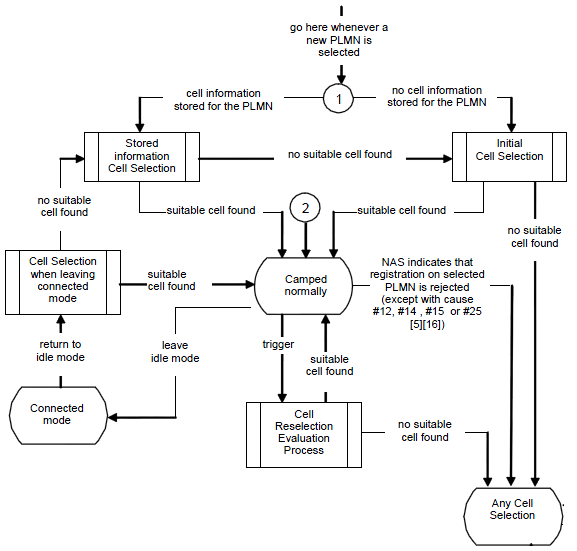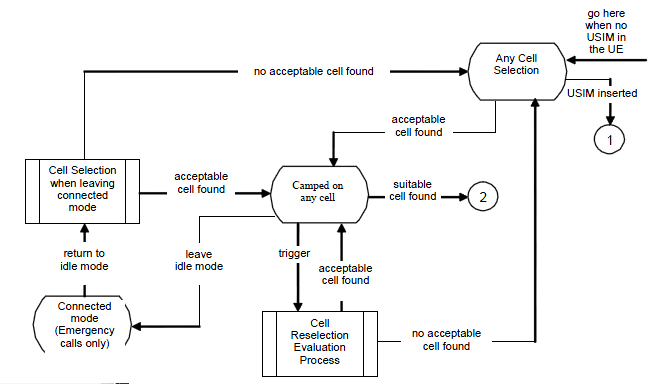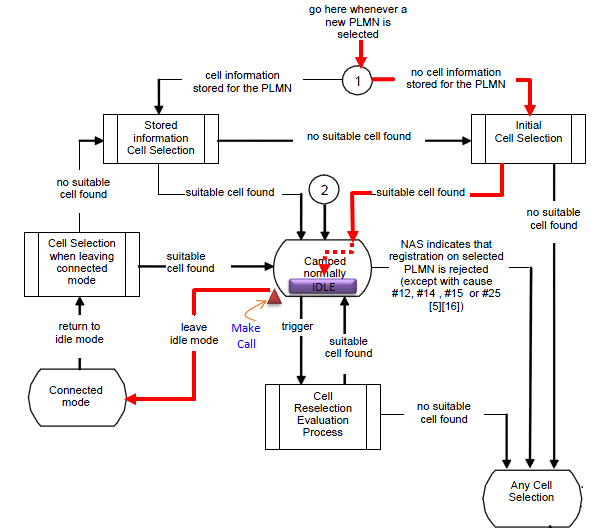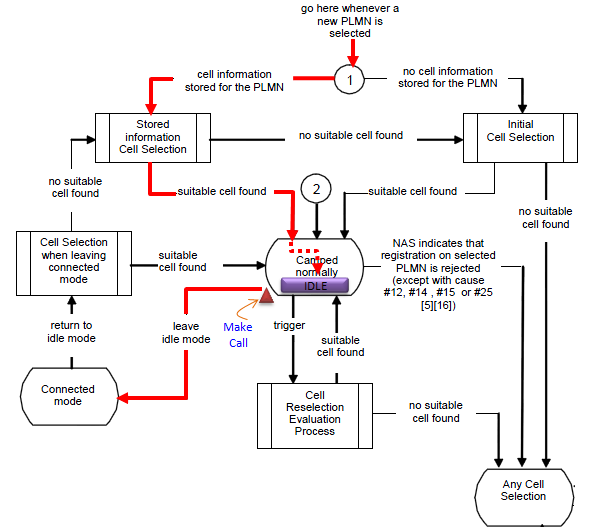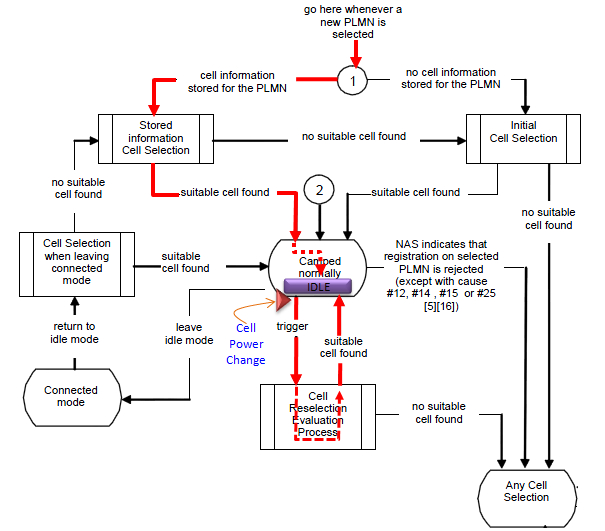|
|
||
|
When you power on the mobile device, in most case the device is under a circumstance where it sees many base station (gNB) around it. In some cases UE would be surrounded not by the multiple basestation from one network operator but by the multiple basestation from different network operators. Out of those many cells, UE can camp on (register) to only one cell. Then the question is which specific single cell the UE have to register. For this UE goes through a specific decision making process to pick up a specific Cell to register, this specific decision making process is called 'Cell Selection'. Cell Selection process in NR is very similar to the Cell Selection Process in LTE. So the description in this page would be almost identical to the LTE Cell Selection page. Overall description of cell selection process is described in 38.304 Figure 5.2.3: Cell Selection Process and 5.2.4 Cell Reselection Evaluation Process Pretty complicated flow diagram, right ? But you will find it even more complicated if you try to associate this flow to the situation you come across when you test the device in real life. You see in this flow diagram many branches and loops which makes it difficult to follow the right path and other thing is that it is not so easy to figure the exact status of the UE when you turn on the UE. Let me give you some examples in which UE needs to go through the cell selection process.
Can you mark the path on this flow diagram for each of the cases listed above ? To be honest, I may be able to do it only a couple of the case and not for all. If you have access to UE logging tools, try to collect field test log in various situation and analize the log according to this flow charts. Only practice would make you understand this clearly unless you are the protocol stack developer who implements this process in UE. Following diagram is from 38.304 Figure 5.2.2-1. (This is exactly same as LTE Process in 36.304). This is the case when UE find a suitable cell. Following is the case where UE fails to find a suitable cell and camp on to any cell that is available. Followings are the keywords that you have to know in order to understand the follow chart shown above. Acceptable CellAcceptable cell is the cell that is not enough to be a suitable cell, but meets the minimum condition at least to make an emergency call. The minimum conditions are
Suitable CellThe cell that the UE may camp on for a normal service. The E-UTRA and UTRA Suitable Cell criteria is defined in 36.304 4.3 Service types in Idle Mode as follows. The cell is part of either:
according to the latest information provided by NAS:
Even though the flow chart shown above handles various situations, if you don't follow through each of the case one by one, it would be difficult for you to get any concrete understanding for each specific case. My recommendation is to mark a specific path for each specific case one by one as examples shown below. Case 1 : Initial Cell SelectionThis flow describes the Initial Cell Selection process in mobile networks, focusing on how the UE selects a suitable cell for communication. This is what happens in your mobile phone when you power on for the first time.
Followings are some highlights on this scenario When a new PLMN (Public Land Mobile Network) is selected, the UE first checks whether it has stored information about cells in this PLMN. If no cell information is stored for the selected PLMN, the UE proceeds to the Initial Cell Selection process.
If no suitable cell is found during the Stored Information Cell Selection or Initial Cell Selection, the red arrow shows that the UE reverts to performing Any Cell Selection.
If the UE finds a suitable cell and camps on it in the Idle state, it attempts to register with the network. If the network rejects the registration with specific causes (e.g., cause #12, #14, #15, or #25), the UE exits the idle state and re-enters the Cell Selection process . While in the Idle state, if the UE is required to make a call or perform any uplink transmission (e.g., mobile-originated call or data session), it transitions from the Idle state to Connected Mode (red arrow). This action triggers a transition to actively communicate with the network. Case 2 : Stored Cell SelectionThis scenario focuses on how the UE utilizes stored information to select a suitable cell for communication.
Followings are some highlights on this scenario When the UE switches to a new PLMN (Public Land Mobile Network), it first checks for stored cell information associated with that PLMN. If cell information is stored, the UE enters the Stored Information Cell Selection process (red arrow). This step enables the UE to quickly identify a suitable cell without initiating a full scan. If no suitable cell is found using stored information, the UE proceeds to the Initial Cell Selection process. If the Stored Information Cell Selection process fails to identify a suitable cell, the UE moves to Any Cell Selection (red arrow). In this fallback scenario, the UE attempts to camp on any available cell, even if it is not part of the selected PLMN. This ensures that the UE can access emergency or limited services if no preferred cell is available. If the UE successfully finds a cell and enters the Idle state, it attempts to register with the network. If the network rejects the registration with specific NAS causes (e.g., #12, #14, #15, or #25), the UE exits the idle state and returns to the Cell Selection process (red arrow). This rejection indicates that the selected PLMN or cell does not meet the UE's requirements, prompting the UE to restart the selection process. While in the Idle state, if the UE initiates a call or requires an uplink communication, it transitions to Connected Mode (red arrow). This involves switching to an active communication state where the UE can transmit and receive data with the network. Case 3 : Cell ReselectionThis scenario describes how the UE evaluates and switches to a more suitable cell while in the Idle state
When the UE is in the Idle state and camped on a cell, it continuously monitors the network for better cell options. A trigger for the Cell Reselection Evaluation Process occurs in scenarios such as:
Upon detecting a trigger, the UE enters the Cell Reselection Evaluation Process (red arrow). This involves:
If a suitable cell is found during this process, the UE reselects the new cell and camps on it. If the Cell Reselection Evaluation Process fails to find a suitable cell, the UE remains camped on the current cell and continues monitoring until conditions improve or another trigger occurs. If the current cell becomes entirely unsuitable (e.g., due to coverage loss), the UE transitions to Any Cell Selection (red arrow), where it attempts to connect to any available cell, even outside the current PLMN. If the UE camps on a suitable cell but the network rejects the registration request with specific causes (e.g., #12, #14, #15, or #25), the UE is forced to reinitiate the selection process. This may involve returning to Cell Reselection or moving to Any Cell Selection, depending on the conditions (red arrow). If the UE is required to initiate communication (e.g., a call or data transmission), it leaves the Idle state and transitions to Connected Mode (red arrow). This ensures the UE can actively communicate with the network.
|
||
